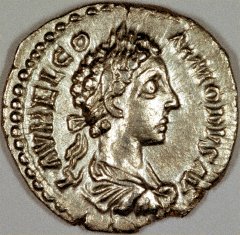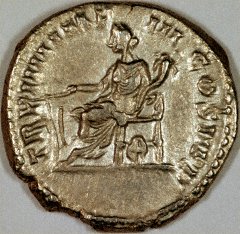| The Very Highest Quality Roman Portraits... |
| Portrait Gallery of Roman Emperors |

| |
|
| |

| |
|
| |
Introduction
The reign of Commodus closely paralleled that of Gaius Caligula nearly one hundred and fifty years earlier. Assuming the purple as an enthusiastic nineteen year old in AD180 on the death of Marcus Aurelius, the Senate and Roman people saw Commodus as an icon of new, happier days to come after the wars and troubles of his father's reign. Similarly, Caligula was welcomed enthusiastically after the death of the brooding Tiberius in AD37. The accession of Commodus sparked the highest hopes in the Romans who believed he would rule as a just and wise emperor like his father. However, like Caligula, absolute power in the hands of an unstable and impressionable youth spelled disaster for the Empire...
Early Days
Marcus Aurelius Commodus Antoninus was born at Lanuvium in Italy on August 31st AD161, the son of the Emperor Marcus Aurelius and his wife Faustina the Younger. Commodus was named as Caesar (junior emperor) in AD166 and as co-ruler (Augustus) with his father in AD178. Commodus spent most of his teenage years accompanying his father on his campaigns against the Quadi and the Marcomanni, two large Germanic tribes on the Danubian frontier. Marcus Aurelius died under suspicious circumstances at the fortress of Bononia on the Danube on 17th March AD180. The old emperor was probably suffering from cancer but his sudden death may have been due to poisoning...!
Pax Commodiana
Commodus had no desire to continue the wars. After his father's funeral, Commodus made hurried peace overtures to the Danubian tribes and he hastened back to Rome to be acclaimed emperor. Commodus, accompanied by much of the Roman army, entered the capital on 22nd October AD180 in triumphal procession and he received a hero's welcome. Like Caligula, the youthful Commodus was cheered by ecstatic crowds, eager for a glimpse of the new emperor. The coins issued in his first year all show the triumphant warrior general, bringing the the spoils of war back to the adoring citizens of Rome. There is much literary evidence to support the fact that Commodus was popular among many of his people, at least for most of his reign. The coins of Commodus from AD183 onwards often have the legend 'Munificentia Augusta' (Munificence of the Augustus), indicating that generosity was a part of his imperial intentions. The emperor distributed largess to the citizens no less than nine times during his reign. Commodus forced the senatorial class to pay increased taxes to support this 'inperial generosity'! This policy certainly caused tensions between Commodus and the Senate, so, while the lower classes and the army loved him, the Senate came to despise Commodus...
Descent into Madness...
Commodus started to associate himself with the gods and he began to dress like the semi-divine Hercules, wearing lion skins and carrying a club. This identification with Hercules can be seen as an attempt to establish his claim as the new founder of Rome. (The new name of Rome was to be Colonia Lucia Annia Commodiana). This was 'enforced' by his direct link to Hercules, son of the father god Jupiter. While the literary sources, especially Dio, Herodian, and the Historia Augusta, all criticise the mad antics of his later career, they also give important insight into Commodus' relationship to the Roman people. He strengthened his claims as Hercules by showing himself as the god to the Roman people; he took part in theatrical spectacles in the Flavian Amphitheatre. Not only would Commodus fight and defeat the most skilled gladiators, he would also test his talents by slaughtering exotic and wild beasts from Africa. Commodus won all of his bouts against the gladiators. Not surprising really, as all his opponents were given lead or defective weapons!
During the later part of his reign Commodus declared that his reign should be called the "Golden Age." Commodus wanted there to be no doubt that this "Golden Age" had been achieved through his generosity as 'the most noble and wisest emperor'. Besides renaming Rome as Colonia Lucia Annia Commodiana, as noted above, the city was designated 'the Immortal, the Fortunate, the Universal Colony of the Earth'. Coins were issued representing the archaic rituals of city-[re]foundation, identifying Commodus as a new founder and his reign as heaven on earth. Furthermore, Commodus renamed all the months to correspond exactly with his titles. From January, they ran as follows: Lucius, Aelius, Aurelius, Commodus, Augustus, Herculeus, Romanus, Exsuperatorius, Amazonius, Invictus, Felix, Pius. According to Dio Cassius, the changing of the names of the months was all part of Commodus' megalomania which knew no bounds...
The legions were renamed Commodianae, the fleet which imported grain from Africa was called Alexandria Commodiana Togata, the Senate was designated as the Commodian Fortunate Senate, the imperial palace and the Roman people were all given the name Commodianus. The day that these new names were announced was also given a new title: Dies Commodianus. The emperor wished to be seen as the centre of Roman life and the fountainhead of religion.
Assassination
Commodus made many enemies due to his extreme behaviour and his insulting treatment of the senatorial class. He was the target of several assassination attempts during his twelve year reign. In AD182 his own sister Annia Lucilla, together with her cousin, the former consul Marcus Ummidius Quadratus, were involved in an unsuccessful plot to assassinate the emperor. The ringleaders of the plot were executed and Lucilla was exiled to the island of Capri, Commodus ordering her execution shortly after. At the end of AD192 a group of senators and high-ranking officers plotted to assassinate Commodus after hearing of the latest round of mad imperial schemes for the New Year. The plotters included several of the emperor's courtiers, apparently including his mistress Marcia. Commodus was fed poisoned food by his mistress on 31st December at a banquet but he was so drunk that he vomited it up! Later that night, Marcia ran to the conspirators and told them that Commodus was lying in his bath in a drunken stupor. The emperor's wrestling partner, an athlete named Narcissus, burst into Commodus' private apartments and strangled him in his bath. The Senate cursed the emperor's memory, passing a 'damnatio memoriae'. The statues and inscriptions of Commodus were smashed in Rome and throughout the Empire. The death of this disturbed and unfortunate emperor brought an end to the Antonine Dynasty and ushered in another brutal round of civil wars.
Featured Coin
The coin we show on this page is a silver denarius. The obverse has a rather startled looking portrait of Commodus at the age of 17, having just been raised to the status of joint Augustus with his father. Perhaps this is because he was aware of the short life expectancy of Roman emperors after taking the purple. It perhaps also explains why the goddess Fortune appears on the reverse, holding a cornucopia, and a ship's rudder. There is a globe or wheel leaning against her chair, the wheel of fortune?
Roman Emperors Portrait Gallery
You may wish to visit our portrait gallery of Roman emperors. Although it is not complete, we add new and better coins when we can. We are always keen to buy superior quality Roman coins to upgrade our photo gallery.
If you want to find the value of a coin you own, please take a look at our page I've Found An Old Coin, What's It Worth?
| ...at the Lowest Possible Price |
|
32 - 36 Harrowside, Blackpool, Lancashire, FY4 1RJ, England. Telephone (44) - (0) 1253 - 343081 ; Fax 408058; E-mail: info@chards.co.uk The URL for our main page is: https://24carat.co.uk Chard(1964) Ltd |